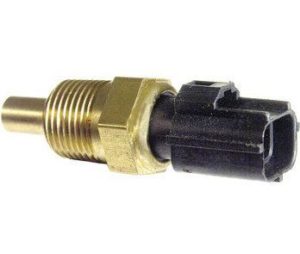
The Engine Coolant Temperature or ECT sensor is often referred to as the master sensor, and is one of the most important sensors in a modern engine. How important?
Consider this: the engine CPU will utilize the readings of the CTS and the oxygen sensor to engage closed-loop mode, which is switching from rich to lean mixture and vice-versa to optimize performance and fuel economy. If your engine has a bad or faulty ECT sensor, then you can experience a lot of weird things happening in your engine.
Can you imagine if your engine is running in open-loop mode (rich mixture) all the time even when you’re idling?
Consider the fact that the coolant temperature sensor is constantly exposed to the scalding coolant inside your engine, and you will be amazed how this little thing can last a hundred thousand miles without fault. But if it fails, it brings along with it a host of problems that might prove to be difficult to diagnose.
The Engine Coolant Temperature sensor is located on the cylinder head, usually found beside or near the engine thermostat in the water jacket. If the engine is cold, the coolant sensor will tell the CPU to perform a closed loop operation and raise the idle speed to quickly heat up the engine. When the engine gets hot enough, the coolant sensor will also tell the CPU to operate the cooling fan to avoid overheating.
Determining the Symptoms of a Bad or Faulty ECT Sensor
Look out for these symptoms. This could mean that your car has a faulty coolant temperature sensor:
- Hard starting, even when the engine is hot. If your vehicle has a faulty ECT sensor, the engine CPU will constantly assume that your engine is cold, and will adjust the fuel mixture accordingly. We all know that a hot engine needs to switch between rich and lean mixtures (closed-loop mode) especially when idling or moving at a moderate pace. But if you have a faulty coolant sensor, then your engine will always run a rich mixture of air and fuel, hence causing your engine to stall, or the inability to start the engine at all.
- Check Engine light on – usually showing a P0128 DTC code
- Poor MPG. This is a given, since the engine is running a rich fuel mixture or is in open-loop mode. The spark timing is also retarded at this point, so your car will be wasting gas at each engine revolution.
- Poor idling or idling instability. Your car will idle poorly, or will constantly vibrate or shake violently, giving the impression that the engine will stall at any given moment.

image credits: Adam - Dirty emissions. Your car will not pass emissions tests if you have a bad coolant temperature sensor, since your engine will burp out more unburned gas than a funny car dragster.
- Engine overheating. In a worst case scenario, your engine might show signs of overheating, since the coolant sensor is also used to gauge the actual engine temperature on some model cars.
How to Avoid Problems with the Engine Coolant Temperature Sensor
As with all vehicle sensors, the engine coolant temperature sensor was designed to last a long time. In fact, if your car is properly maintained, it might last as long as the car. Here are a few tips that will help you to avoid problems with a faulty ECT sensor:
- Do not use tap water to refill the radiator or the coolant reservoir. Tap water contains element of rust and other minerals that might prove harmful in the long run, especially when the water boils and evaporates inside the radiator. Coolant prevents the water from boiling, and it also lubricates the engine block and the radiator, preventing rust formation. Always use the right mix of water and coolant in your vehicle. When in doubt, consult the owner’s manual.
- Fix oil leaks or gasket leaks immediately. If oil enters the engine block, the coolant will get contaminated, thereby reducing the service life of the coolant temperature sensor.
- Fix coolant leaks immediately. The cooling system in your vehicle is a sealed-type system, and it is unusual if you constantly need to refill the reservoir with water. If there is inadequate coolant in the system, the engine coolant sensor might get false readings, which will affect engine performance.
In the presence of a check engine light, it is hard to take chances. Get yourself a quality vehicle scanner like the Autel AL519 Color Screen OBD-II/CAN Scan Tool so you can easily determine if you have a faulty coolant temperature sensor. Or if you’d like, check out our selection of the best OBD2 scanners for Android.
OBD2 scanners are also helpful to read live data in case you suspect ECT issues.